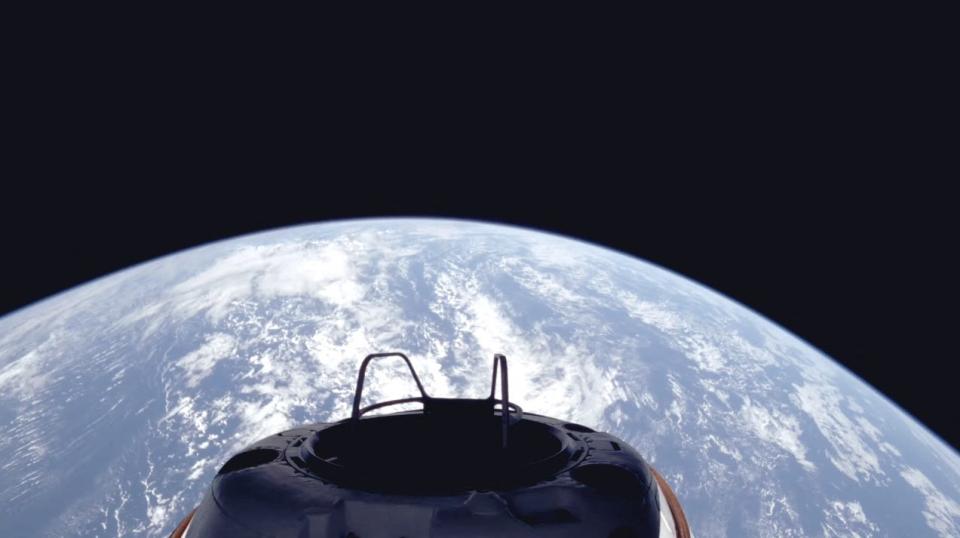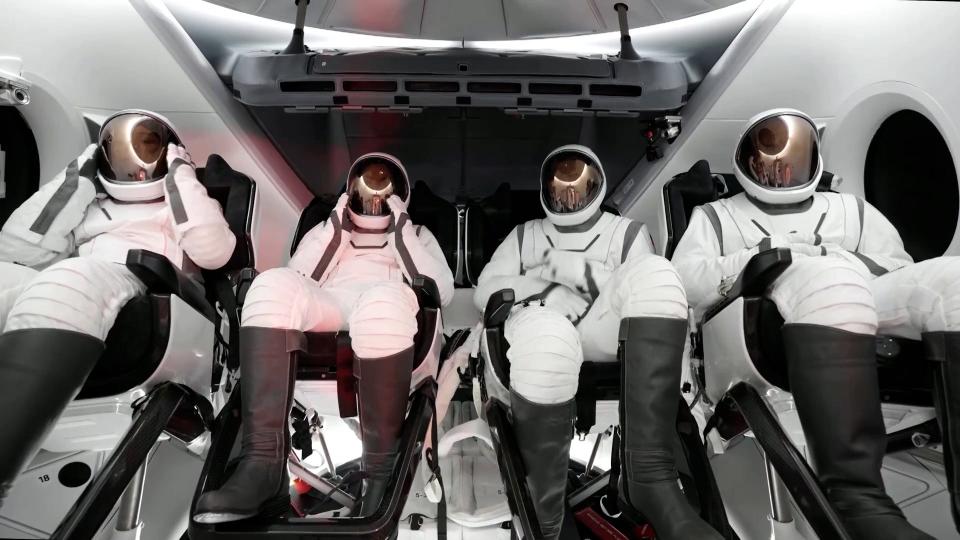Billionaire Jared Isaacman and crew complete historic spacewalk: 'Looks like a perfect world'
For the first time ever, a crew of private spacefarers have pulled off a daring orbital maneuver that until now had only been left up to government astronauts.
In the predawn hours of Thursday, the crew of the Polaris Dawn mission suited up in specially-designed SpaceX gear in preparation of enduring the vacuum of space some 435 miles above Earth. When billionaire entrepreneur Jared Isaacman and SpaceX employee Sarah Gillis then exited their SpaceX Dragon capsule, they became the first commercial astronauts to ever do so.
Because the Dragon has no airlock, the other two members of the crew, Anna Menon and Scott “Kidd” Poteet, were also exposed to the conditions of space despite remaining in the vehicle.
The pioneering private spacewalk came on the third of the five-day Polaris Dawn mission, which Isaacman is commanding and helping to fund along with SpaceX. The first of three missions under the Polaris Program, the venture is intended to test technology that could one day make SpaceX founder Elon Musk's vision of crewed trips to Mars a reality.
When the mission launched Tuesday, the SpaceX Dragon capsule bearing the astronauts traveled further into space than any spacecraft has gone in more than 50 years, surpassing the height reached by NASA's Gemini 11 in the 1970s, SpaceX said.
“This incredible milestone is all thanks to the hard work of the crew and many SpaceX teams, all focused on a goal of making life multiplanetary,” Stu Keech, vice president of Dragon at SpaceX, said in a statement.

Rewatch Polaris Dawn launch: Video shows SpaceX rocket launch 4-member crew for daring commercial mission
Two exit SpaceX Dragon for commercial spacewalk
Preparations for the spacewalk began after the astronauts reached orbit on Tuesday.
Shortly after liftoff, the Dragon's pressure began to slowly lower while oxygen levels inside the cabin increased, helping to purge nitrogen from the crew members' bloodstreams. The protocol was to prepare the astronauts for the spacewalk and lower the risk of decompression sickness, SpaceX said.

After the spacecraft reached a maximum height of about 870 miles above Earth's surface, the Dragon was to descend to a cruising orbit about 435 miles above Earth for the spacewalk itself.
When it came time around 6 a.m. Thursday to conduct the maneuver, Isaacman was the first to venture out of the Dragon into the weightlessness of space. As he emerged from the forward hatch, the adventurer and experienced pilot soaked in the stunning view.
"Back at home we all have a lot of work to do, but from here Earth sure looks like a perfect world," Isaacman said as the ground crew on the livestream burst into applause.
Commander @rookisaacman has egressed Dragon and is going through the first of three suit mobility tests that will test overall hand body control, vertical movement with Skywalker, and foot restraint pic.twitter.com/XATJQhLuIZ
— SpaceX (@SpaceX) September 12, 2024
Gillis followed him shortly afterward, climbing out the “Skywalker” ladder at the top of the capsule to catch her first glimpse of the expanse of space. Gillis, an engineer who oversees astronaut training at SpaceX, was participating with the additional benefit of gaining invaluable experience to train future astronauts, SpaceX officials have said.
Gillis was then able to reenter the vehicle and securely latch and close the hatch so that the crew could begin repressurizing the cabin.

Spacewalk timeline
Here's a look at how the Polaris Dawn spacewalk unfolded Thursday morning.
1:35 a.m.: SpaceX announces that the spacewalk was delayed from its initial start time at around 2 a.m. and will begin at 5:58 a.m. EDT. A reason for the delay was not provided.
5:14 a.m.: The crew gets into their spacesuits to prepare for the cabin pressure to lower to that of the vacuum of space. While Isaacman and Gillis test the mobility of the spacesuits outside the capsule, Poteet and Menon will remain strapped in their seats and ready to offer support.
5:25 a.m.: The crew performs communication checks.
5:55 a.m.: The crew is ready for seat rotation. The seats will be rotated so the crew has more room to move.
6:00 a.m.: The SpaceX suits come complete with a heads up display, which displays stats in the crew member's visors. It shows data such as oxygen and temperature. They have approximately one hour and 50 minutes to complete the spacewalk. There are now live views from the spacecraft. The crew will have helmet cams, giving us live views of what the crew is seeing.
6:09 a.m.: SpaceX gives the go to start the spacewalk. The crew's spacesuits begin to pressurize.
6:12 a.m.: The spacewalk officially begins.
6:22 a.m.: The crew finishes final pre-breath operations, a process to avoid decompression sickness.
6:30 a.m.: The cabin is vented, which brings Dragon down to vacuum. According to SpaceX, it will take eight minutes to match the vacuum of space. For the first time in history, all four crew members will technically be on a spacewalk.
6:50 a.m.: Isaacman opens the hatch prepares to venture outside.
7:00 a.m.: Isaacman moves back inside to make way for Gillis to exit using the Skywalker.
7:04 a.m.: Gillis observes part of the seal on the hatch popped out, but it can simply be popped in, according to SpaceX.
7:06 a.m.: Sarah Gillis is outside testing the spacesuit. SpaceX employees erupt into cheers to see one of their own preform a spacewalk.
7:14 a.m.: Gillis was heard saying the seal has bulges again. She pops them back in place and prepares to close the hatch.
7:16 a.m.: The Dragon hatch is now closed and sealed so that the spacecraft can be pressurized. The process is expected to take about an hour, SpaceX said.
7:30 a.m.: Oxygen is added into the cabin. Nitrox (Oxygen and Nitrogen mixture) will soon be added to the suits to take the crew out of the pure oxygen environment of the suits.
7:40 a.m.: The cabin continues to pressurize, and no leaks have been found. The process is slow, as like in scuba diving, there must be safety stops when changing to a different pressure ? as not to overexert the body.
7:55 a.m.: The Dragon spacecraft has returned to a normal pressure such as what the astronauts are accustomed to on Earth. That means the crew can now get out of their EVA suits, officially ending the spacewalk.
All 4 Polaris Dawn astronauts exposed to the vacuum of space
Until now, spacewalks have only ever been the purview of government spacefarers such as NASA astronauts and Russian cosmonauts. What's more, the maneuvers most often take place in craft with airlocks.
But because the Dragon does not have an airlock, the entire spacecraft had to be depressurized when the hatch was opened, exposing the entire crew to the vacuum of space. For that reason, even mission specialist Menon and pilot Poteet needed to wear extravehicular activity (EVA) suits designed by SpaceX to receive oxygen through tethers.

Not only have spacewalks historically not been commercial endeavors, but those who have taken part have done so in spacesuits regulated by a government space agency.
This time it is all being done by SpaceX. The purpose of the operation, which took about two hours, was to test the suit's capabilities, which the rocket company developed for this flight.
Congratulations @PolarisProgram and @SpaceX on the first commercial spacewalk in history!
Today’s success represents a giant leap forward for the commercial space industry and @NASA's long-term goal to build a vibrant U.S. space economy. https://t.co/9cBwpeWUAT— Bill Nelson (@SenBillNelson) September 12, 2024
Aside from providing a launch site at its Kennedy Space Center, NASA is not part of the Polaris Dawn mission. But after the historic spacewalk, NASA Administrator Bill Nelson took to X to congratulate SpaceX and the crew.
"Today’s success represents a giant leap forward for the commercial space industry and NASA's long-term goal to build a vibrant U.S. space economy," Nelson said in the post.
What is the Polaris Dawn mission?
Polaris Dawn is the first of three human spaceflights under the Polaris Program, all of which are intended to test SpaceX technologies needed to carry humans deep into the cosmos.
Isaacman, founder of internet company Shift4 Payment, is the only member of the Polaris Dawn crew to have been to outer space before. Menon and Gillis are also now not only the the first SpaceX employees to travel to space, but have traveled higher than any other women in history.
The crew have already been testing a new laser-based satellite communication system using Starlink.
Before and after the spacewalk, the crew is also conducting nearly 40 scientific experiments – many of which aim to understand the human body's reaction to long spaceflights as NASA and other space agencies set their sights on destinations like Mars.
The SpaceX Dragon will return the Polaris Dawn astronauts to Earth on Sunday, making a splashdown landing off the Florida coast.
This article originally appeared on USA TODAY: Polaris Dawn crew make historic commercial spacewalk on SpaceX Dragon
